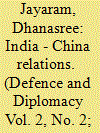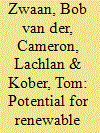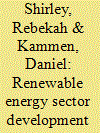|
|
|
Sort Order |
|
|
|
Items / Page
|
|
|
|
|
|
|
| Srl | Item |
| 1 |
ID:
113480


|
|
|
|
|
| Publication |
2012.
|
| Summary/Abstract |
According to binding European Union agreements, the Netherlands has to cover at least 14% of its total energy use with renewable energy sources by 2020. However, the share of renewable energy in the Netherlands is small and hardly increasing. In 2010, renewable energy in the Netherlands accounted for only 3.8% of the national energy use, and has decreased with 0.4% compared to 2009. A cause of the stagnating renewable energy generation in the Netherlands is the absence of a nation-wide, clear and consistent long-term policy on the introduction of renewable energy. In order to overcome the current standstill in renewable energy adoption, several Dutch municipalities take the initiative and establish Local Energy Companies (LECs). However, to date, it is unclear which LEC type performs best. This research aims to compare the performance of existing LECs on three aspects: technology, finance, and organization. Furthermore, the performance of existing LECs is compared with theoretical reference LECs, in order to estimate efficiencies and opportunities for improvements. Finally, the influence of the recent changes in the Dutch subsidy scheme on LEC performance is examined. In order to achieve these aims, the benchmark method Data Envelopment Analysis is employed.
|
|
|
|
|
|
|
|
|
|
|
|
|
|
|
|
| 2 |
ID:
125558


|
|
|
|
|
| Publication |
2013.
|
| Summary/Abstract |
Existing literature indicates that theoretically, the earth's wind energy supply potential significantly exceeds global energy demand. Yet, only 2-3% of global electricity demand is currently derived from wind power despite 27% annual growth in wind generating capacity over the last 17 years. More than 95% of total current wind power capacity is installed in the developed countries plus China and India. Our analysis shows that the economic competitiveness of wind power varies at wider range across countries or locations. A climate change damage cost of US$20/tCO2 imposed to fossil fuels would make onshore wind competitive to all fossil fuels for power generation; however, the same would not happen to offshore wind, with few exceptions, even if the damage cost is increased to US$100/tCO2. To overcome a large number of technical, financial, institutional, market and other barriers to wind power, many countries have employed various policy instruments, including capital subsidies, tax incentives, tradable energy certificates, feed-in tariffs, grid access guarantees and mandatory standards. Besides, climate change mitigation policies, such as the Clean Development Mechanism, have played a pivotal role in promoting wind power. Despite these policies, intermittency, the main technical constraint, could remain as the major challenge to the future growth of wind power.
|
|
|
|
|
|
|
|
|
|
|
|
|
|
|
|
| 3 |
ID:
119678


|
|
|
| 4 |
ID:
183128


|
|
|
|
|
| Summary/Abstract |
In the race to achieve climate goals, many governments and organizations are encouraging the local development of Renewable Energy Technology (RET). The spatial innovation dynamics of the development of a technology partly depends on the characteristics of the knowledge base on which this technology builds, in particular the analyticity and cumulativeness of knowledge. Theoretically, greater analyticity and lesser cumulativeness are positively associated with more widespread development. In this study, we first empirically evaluate these relations for general technology and then systematically determine the knowledge base characteristics for a set of 14 different RETs. We find that, while several RETs (photovoltaics, fuel cells, energy storage) have a highly analytic knowledge base and develop more widespread, there are also important RETs (wind turbines, solar thermal, geothermal, and hydro energy) for which the knowledge base is less analytic and which develop less widespread. Likewise, the technological cumulativeness tends to be lower for the former than for the latter group. This calls for regional and country-level policies to be specific for different RETs, taking for a given RET into account both the type of knowledge it builds on as well as the local presence of this knowledge.
|
|
|
|
|
|
|
|
|
|
|
|
|
|
|
|
| 5 |
ID:
124251


|
|
|
|
|
| Publication |
2013.
|
| Summary/Abstract |
Based on employment factors derived from a recent review of publications investigating opportunities for work associated with the diffusion of renewable energy technology, we here present an analysis of the potential for renewable energy jobs in the Middle East. We use energy system optimisation results from the regionally disaggregated TIAM-ECN model as input to our study. This integrated assessment model is utilised to inspect the energy technology requirements for meeting a stringent global climate policy that achieves a stabilisation of greenhouse gas concentrations in the atmosphere with a maximum additional radiative forcing of 2.9 W/m2. This climate control target implies a massive deployment of renewable energy in the Middle East, with wind and solar power accounting for approximately 60% of total electricity supply in 2050: 900 TWh of an overall level of 1525 TWh would be generated from 210 GW of installed renewable energy capacity by the middle of the century. For this pervasive renewables diffusion scenario for the Middle East we estimate a total required local work force of ultimately about 155,000 direct and 115,000 indirect jobs, based on assumptions regarding which components of the respective wind and solar energy technologies can be manufactured in the region itself. All jobs generated through installation and O&M activities are assumed to be domestic.
|
|
|
|
|
|
|
|
|
|
|
|
|
|
|
|
| 6 |
ID:
121360


|
|
|
|
|
| Publication |
2013.
|
| Summary/Abstract |
Island regions and isolated communities represent an understudied area of not only clean energy development but also of innovation. Caribbean states have for some time shown interest in developing a regional sustainable energy policy and in implementing measures which could help to protect its member states from volatile oil markets while promoting reliance on local resources. Here we examine four case studies of renewable energy advancements being made by public utility companies and independent energy companies in the Caribbean. We attempt to locate renewable energy advances in a broader historical framework of energy sector development, indicating a few policy lessons. We find that different degrees of regulatory and legislative sophistication have evolved in different islands. Islands should have specialized policy focus, contrasting the ad-hoc nature of current regional energy policy discussion. We also conduct a cost benefit analysis which shows that these early, innovative alternative energy projects show themselves to be both profitable and significant sources of emissions reduction and job creation. This lends support to the potential benefits of regional energy policy.
|
|
|
|
|
|
|
|
|
|
|
|
|
|
|
|
| 7 |
ID:
150373


|
|
|
|
|
| Summary/Abstract |
Despite various policies, renewable energy resources have not been developed in Malaysia. This study investigates the factors that influence renewable energy technology acceptance in Peninsular Malaysia and attempts to show the impact of cost and knowledge on the perceived ease of use and perceived usefulness of renewable energy technology. The results show that cost of renewable energy has an indirect effect on attitudes towards using renewable energy through the associated impact on the perceived ease of use and perceived usefulness. The results also indicate that public knowledge in Peninsular Malaysia does not affect perceived ease of use, although the positive impact of knowledge on perceived usefulness is supported. Furthermore, our results show that the current business environment in Peninsular Malaysia does not support the adoption of renewable energy technology, and thus, renewable energy technology is not commercially viable in Peninsular Malaysia. Additionally, the population of Peninsular Malaysia associates the use of renewable energy with a high level of effort and therefore has a negative attitude towards the use of renewable energy technology. There is, therefore, a definite need to pay more attention to the role of public perception and awareness in the successes and failures of renewable energy policy.
|
|
|
|
|
|
|
|
|
|
|
|
|
|
|
|
| 8 |
ID:
177505


|
|
|
|
|
| Summary/Abstract |
This paper constructs a knowledge-stock indicator to explore the trend of renewable energy technology innovation (RETI) levels across China's provinces during 1997–2015. First, the spatial-temporal evolution is analyzed. Second, the convergence characteristics and patterns are identified through the nonlinear time-varying factor model and the relative transition path curves. Third, the drivers of convergence behaviors are examined. The results are as follows: (i) China's RETI experienced a spurt of development. Its spatial pattern has changed significantly, and the average annual growth rate has also shown spatial differences; (ii) China's provincial RETI level was not converged as a whole during the sample period, but exhibited club convergence characteristics. The 30 provinces eventually converged to three clubs with large differences in average RETI level and annual growth rate; (iii) the provinces with a more optimized industrial structure, a greater R&D investment intensity, and a higher environmental regulation intensity tended to converge to the club with a higher innovation level and growth rate.
|
|
|
|
|
|
|
|
|
|
|
|
|
|
|
|
|
|
|
|
|